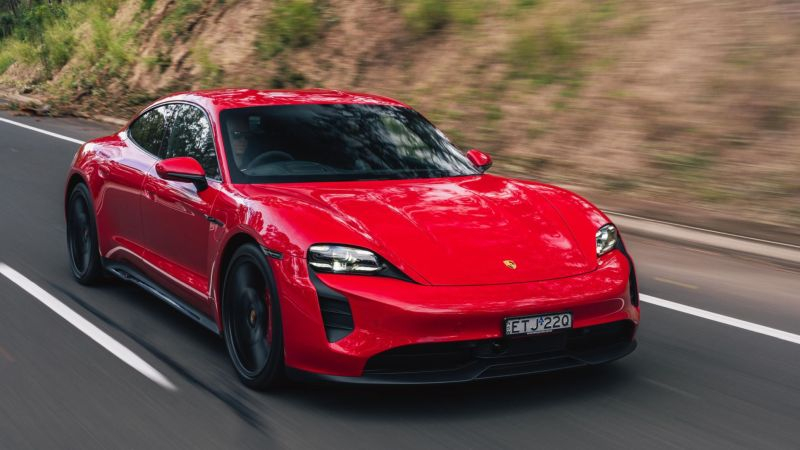The publication Wired undertook to find out how high the dynamics of electric vehicles losing their residual value in the secondary market is, and the conclusions obtained by the authors of the investigation may shock many car owners. In the USA and Great Britain, electric cars lose up to 50% of their original cost in just one year of operation, and neither subsequent years of use nor mileage in the future provide such a sharp reduction in price.

Image source: Porsche
The authors of the publication on the pages of Wired came to the corresponding conclusions after studying the offers of electric vehicles on the secondary market in the UK and the USA. The sample included six fairly popular models, and the search filters were set to 12 months based on the “age” of the electric vehicle and 16,000 km (10,000 miles). As it turned out, the Audi e-Tron GT loses 49% in price in the first year, and this despite the fact that new in the UK it is offered for an impressive $138,000. The American Ford Mustang Mach-E lost 52% of its value in the first year of operation, and The Polestar 2 model, produced by the Chinese Geely in collaboration with Volvo, lost the same 52% in price over the year.
Compared to them, the Tesla Model 3 looks a little better, which in the British market loses 45% of its value over the year, and the authors of the study partly explain this by the fact that this automaker is trying to regularly improve the consumer qualities of its electric vehicles by constantly updating the software. The Porsche Taycan, which is not the cheapest initially, loses 49% of its original cost in the first year, and the much more affordable Hyundai Ioniq 5 still becomes twice as expensive.
Interestingly, in the UK, EV mileage does not reduce residual value as much. For example, if a Polestar 2 increases its range from 16,000 to 32,000 km, then the price of the electric car on the secondary market decreases by only 2%. The more expensive Porsche Taycan demonstrates approximately the same dynamics. The age of the car also has little effect on the cost of a used electric car after the first 12 months of operation. At the same time, for the British secondary market as a whole, if we take into account the statistics for cars with internal combustion engines, such rates of price loss are not typical. As a rule, comparable models with internal combustion engines of the same age are more than 40% more expensive than similar used electric vehicles.
In the US market, the loss of residual value of electric vehicles is not as rapid, but it could easily exceed 40% in the first year. In addition, the average annual mileage here is noticeably higher than in the UK: 22,400 versus 11,200 km. According to iSeeCars statistics, in the US secondary market, an electric car loses an average of 49.1% of its original value over five years. For cars with internal combustion engines, this figure does not exceed 38.8%, and the shortage of cars caused by the pandemic has raised prices on the secondary market, and they still exceed the level of 2019. Now the average price of a used electric car in the United States has dropped to $28,800, while for cars with internal combustion engines this value is $31,400.
At the lower end of the UK market there is a decent selection of electric vehicles available at low prices. For example, the compact electric car Renault Zoe can be purchased here with mileage for $6,400, and the larger Citroen e-C4 will cost a moderate $15,000. Concerns about the high cost of replacing traction batteries are not entirely justified, since during the life of such a need in the UK they face approximately 2.5% of owners, and the cost of the procedure ranges from $6,500 to $20,000.
Buyers of expensive electric vehicles in the secondary market lose more. For example, in the UK, the Mercedes-Benz EQE managed to lose $51,000 of its value in three months of operation with a mileage of 7,200 km. Literally, it was cheaper by $615 per day, even if it was not in use at a particular time.
As the authors of the study explain, prices in the secondary market were seriously affected by price wars in the primary market, which forced automakers to rapidly reduce prices for new cars. Used ones simply could not be offered at adequate prices, and therefore rapidly became cheaper. The frequent release of new models on the electric vehicle market also contributes to the rapid depreciation of cars already in use on the market. However, this situation did not prevent electric vehicles from occupying 18.5% of the primary market in the UK at the end of July this year. In the US, their share reached 6.8%, four times ahead of rechargeable hybrids. An electric car, as the authors summarize, tends to lose its value as much as possible in the first 12 months, and therefore its value more or less stabilizes. From this point of view, it makes sense for the owner to count on long-term operation. Buying a “young” electric car with mileage also seems quite profitable.